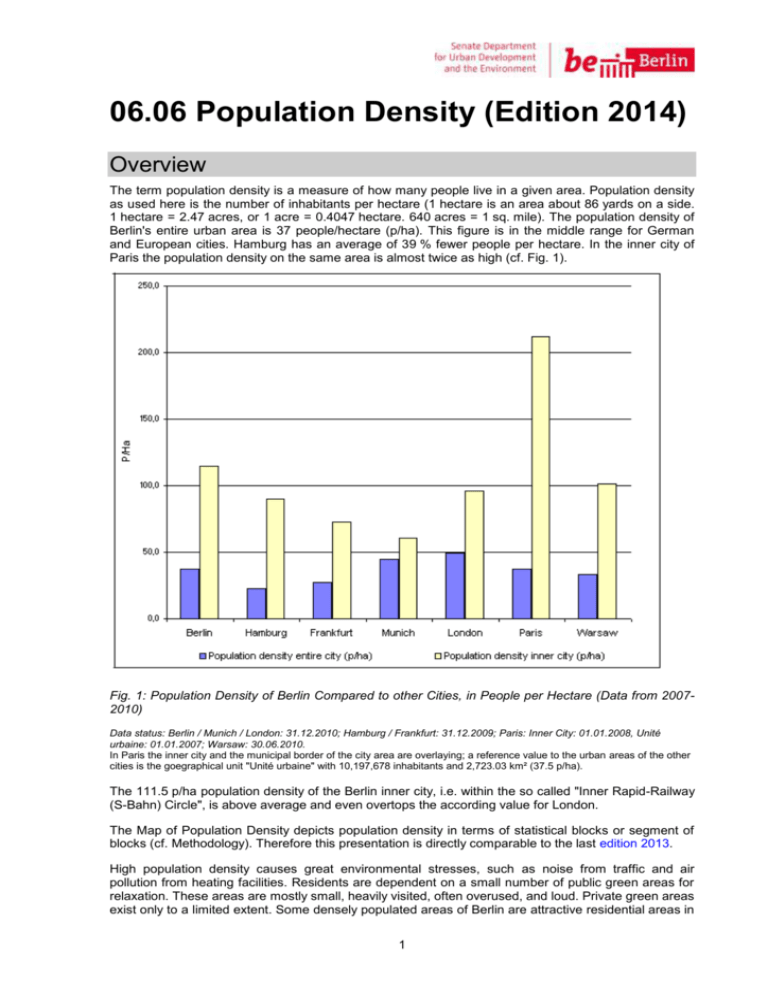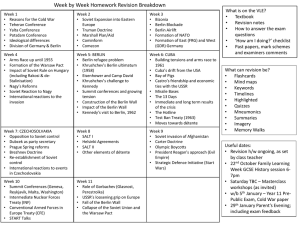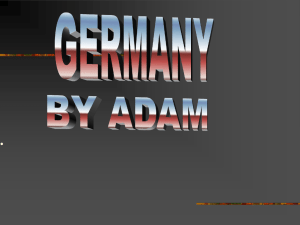06.06 Population Density (Edition 2014)
advertisement

06.06 Population Density (Edition 2014) Overview The term population density is a measure of how many people live in a given area. Population density as used here is the number of inhabitants per hectare (1 hectare is an area about 86 yards on a side. 1 hectare = 2.47 acres, or 1 acre = 0.4047 hectare. 640 acres = 1 sq. mile). The population density of Berlin's entire urban area is 37 people/hectare (p/ha). This figure is in the middle range for German and European cities. Hamburg has an average of 39 % fewer people per hectare. In the inner city of Paris the population density on the same area is almost twice as high (cf. Fig. 1). Fig. 1: Population Density of Berlin Compared to other Cities, in People per Hectare (Data from 20072010) Data status: Berlin / Munich / London: 31.12.2010; Hamburg / Frankfurt: 31.12.2009; Paris: Inner City: 01.01.2008, Unité urbaine: 01.01.2007; Warsaw: 30.06.2010. In Paris the inner city and the municipal border of the city area are overlaying; a reference value to the urban areas of the other cities is the goegraphical unit "Unité urbaine" with 10,197,678 inhabitants and 2,723.03 km² (37.5 p/ha). The 111.5 p/ha population density of the Berlin inner city, i.e. within the so called "Inner Rapid-Railway (S-Bahn) Circle", is above average and even overtops the according value for London. The Map of Population Density depicts population density in terms of statistical blocks or segment of blocks (cf. Methodology). Therefore this presentation is directly comparable to the last edition 2013. High population density causes great environmental stresses, such as noise from traffic and air pollution from heating facilities. Residents are dependent on a small number of public green areas for relaxation. These areas are mostly small, heavily visited, often overused, and loud. Private green areas exist only to a limited extent. Some densely populated areas of Berlin are attractive residential areas in 1 spite of this. Some late 19th-century block-style constructions are especially attractive when they have living quarters of generous size, and are complemented by a good infrastructure of small businesses, restaurants, cultural facilities, services, and an extensive public transportation system. Rich urban life flourishes here. This urbanity is missed by many living in the purely residential areas at the edge of the city. These areas have a relatively low population density, a high ratio of open space, and less air and noise pollution. The inner city boroughs of Mitte, Tiergarten, Wedding, Prenzlauer Berg, Friedrichshain and Kreuzberg reached their greatest population density in 1910 with 312 p/ha. Today, the population density of these boroughs has dropped to 110 p/ha, one-third of the peak value (cf. Fig. 2). Fig. 2: Development of Population Density for Selected Berlin Boroughs (people/hectare within Berlin boroughs) Population figures for inner city boroughs existed only as a total sum for the years 1871 and 1900. No population data for the eastern city boroughs was available between 1949 and 1975. This prevented a calculation of population density for inner city boroughs for these years. In contrast, the population in the outer boroughs rose continuously, except for a drop in 1945 caused by general war-time conditions. In 1933, the Tempelhof borough had an even higher average population density than the Kreuzberg borough. While in 1996 a continuous growth in population of up to 300,000 people was expected by 2010, a more complex development took place: After a peak in 1993 with nearly 3,48 Million inhabitants the number decreased to 3,44 Million in 2000. Since then, the number has increased quite continuously to 3,52 Million inhabitants (relating to mandatorily registered residents who have stated Berlin to be their main place of residence, date: 31.12.2013, State Statistical Institute Berlin-Brandenburg). Lower population density results not only from high proportions of green and open spaces and lesser degrees of development. Lower density can also be due to a large amount of small business, trade and service use, as well as public facilities, etc.. These property areas are included in calculations of population density, as long as they are not separated in an own segment of a block. Detailed and current data bases of population density in specific urban areas are useful for the planning of various public departments. The Department of Urban Planning, for example, uses these figures as a basis for planning such infrastructure facilities as schools, businesses and playgrounds. Landscape Planning uses these figures for analyzing the number and accessibility of green spaces near to residential areas (cf. Map 06.05, SenStadt 2009). Knowledge of population density also allows 2 conclusions to be drawn regarding environmental stresses, such as calculating the number of persons exposed to road traffic noise in their dwellings (cf. Map 07.05, SenStadtUm 2013). Statistical Base The present map is based on the file “Inhabitants Legally Registered at the Places of their Main Residence in Berlin”, as of December 31, 2013, of the Berlin-Brandenburg Office of Statistics. The statistical system of the Residents’ Registration Office evaluates the data on all legally registered residents. As state-specific statistics, they primarily serve to provide small-scale demographic data, and to certify foreign residents according to their citizenships. It supplements the Official Population Extrapolation, which was provided with an updated statistical base with the 2011 Census (valid as of May 9, 2011), and is used primarily for statistical purposes, for instance to calculate the size of the federal-state revenue equalization. However, due to the different systems they use, there are deviations between the statistics of the Residents’ Registration Office (as of December 31, 2013: 3,517,362) and those of the Official Population Extrapolation (as of October 31, 2013: 3,415,091). The latter is continued biannually on the basis of census data and of new registrations/ de- registrations). As an administrative register, the Residents’ Registration Office cannot fully meet the precision requirements necessary for statistical accuracy. Thus for example the correction to account for registration deadlines with regard to residents’ moves, births or deaths currently still involves inevitable imprecision. As a result of the issuance of uniform tax ID numbers, a particularly large number of foreigners who were no longer present at their legally registered addresses have been officially removed from the registry. The current results are therefore only comparable to a limited degree to those of previous years. For the present map, all of the currently existing 381,000 Berlin address data were assigned to the block and block segment areas of the land-use file of the Urban and Environmental Information System (ISU). That made it possible to aggregate resident data not only at the level of statistical blocks, but also at that of the so-called block segments of the ISU, and thus obtained a presentation which can be directly compared with the preceding 2013 Edition. Several factors that influence the precision of the data stock presented: For reasons of statistical confidentiality, cases with only one or two examples may not be presented with their real values. Therefore, in the case of block and block segment evaluations, these confidential cases (values “1” or “2”) are changed in such a way that they occur either three times or not at all. For this reason, no absolute resident values of less than “3” occur. Combinations of characteristics with an occurrence of “1” or “2” of reassigned in such a way that ultimately, only combinations are present which occur either not at all or at least three times. The automatic confidentiality procedure used can not only prevent table values of less than “3” from occurring, but can also ensure that all evaluations lead to identical marginal total results. This procedure, optimized for both such issues, means that distortions are inevitable even for more frequently occurring fields in the table. Moreover, the administrative register cannot completely fulfill the precision requirements for statistics of a population register. For instance, the deadline date excerpt contains listings of noncurrent residents and cases of non-registration of actual residents, due to moves, births and deaths. These limitations have to be taken into account when interpreting the figures. The sizes of the particular blocks and block segments have been calculated directly from the block map ISU5 1:5000. Methodology The spatial reference system was provided by the digital block map 1:5,000 (ISU 5), edition 2010/12/31. This working map contains the individual statistical blocks with their respective block numbers. Blocks with more than one use are divided into block segments. The numbering and street limit lines of blocks correspond to those used by the State Statistical Agency Berlin-Brandenburg. Population density was determined for each statistical block and accordingly for block segments. The size of each statistical block, needed for the calculation of population density, was calculated using the 3 equiareal map ISU5 1:5,000. Figures for the number of inhabitants were assigned to statistical blocks and block segments according to the ISU spatial reference system. Map Description Berlin is characterised by a grown multi central structure with two main centers beside the specific district centers: the areas "Zoologischer Garten" and "Mitte". As a rule, population density increases from the city edge to the city center, however there are some focal points in the borough centers like Spandau, Tegel and Köpenick. Particulary the region of the central area Mitte, that means the area around the eastern Greater Tiergarten and in the north and south of the boulevard Unter den Linden is predominantly formed by its functions as the governmental area and as a supra regional and significant center for services and commerce. Only in some blocks more than 70 p/ha are found. Leipziger Strasse (street) and the new residence units on Wilhelmstrasse are densely populated and are conspicuous exceptions to general conditions in the city center. In contrast the second berlin wide meaningful center around the Zoologischer Garten and along the boulevard Kurfürstendamm is more or less well preserved as a residential area, whereby this is a relevant contribution to the vitality of city life. The Wilhelminische Ring stands out with a "predominately high population density of 351 and more p/ha". The area has a block structure from the late 19th-century and is located within and on the edge of the City Rail Circle line. Maximum values with more than 700 p/ha occur only in about 20 of the overall 14,500 blocks and block segments in Berlin. These areas are located in the boroughs of Neukölln, Kreuzberg and Lichtenberg. Outside the City Rail Circle line, the relatively high population density continues south into the Schöneberg, Friedenau, and Steglitz boroughs. Population distribution similar to that within the inner City Rail Circle line is found in older development areas of Spandau, and is similar to other areas such as Tegel, Schöneweide, Adlershof, and Tempelhof. When these areas were developed around the turn of the century, they were on the edge of Berlin. They were later incorporated into Berlin. The high-rise and industrially-prefabricated settlements at the edge of the city are relatively densely populated with 151 to more than 350 p/ha in large block areas. These are Märkisches Viertel, Hohenschönhausen, Marzahn, Hellersdorf, and Gropiusstadt. Small settlements with post-war high-rise development fall predominately in the 151 to 250 p/ha range. These areas at the edge of the city in Spandau, Lichterfelde, Marienfelde, Waidmannslust, Bohnsdorf, and Köpenick are relatively less densely populated. Some locations in this population density class are settlements with block-edge and row development. Examples are Haselhorst, Siemensstadt, Zehlendorf, and Plänterwald. Typical for the city edge, and the most numerous, are relatively thinly populated settlements with 5 150 p/ha. These blocks are block-edge or row development, 71 - 150 p/ha; low developments with yards, 5 - 70 p/ha; and villa developments with park-like gardens and some semi-private re-greening, 31 - 70 p/ha. An interesting development can be observed at the eastern city border in comparison to the meanwhile nearly 20 years old map of the population density in 1994. Because of divisions of real estates and in the consequence constructional compressions the predominant number of blocks are nowadays in the density category of 31-70 p/ha, whereas for the data from 1994/31/12 blocks with less than 30 p/ha are in the majority. Therefore as a result of this development in the field of population density the eastern border of Berlin bears resemblance to the western border. The distribution of population density correlates quite clearly with Environmental Atlas Map 06.07, "Urban Structure". It is apparent that area types can be assigned a certain range of population density. Table 1 gives average population densities for residential area types (proportion of more than 75% of the use within the area) and respectively Mixed Areas I (more than 25% proportion of trade and services). These calculations are based only on areas (blocks or block segments) of uniform use. 4 Tab. 1: Average Population Density per Area Type and Use For blocks with non-uniform use the population density is displayed very detailed in block segments with uniform use - and this is an important progress in comparison to the first edition of this map. Instancing the block north of the Innsbrucker Platz along the Hauptstrasse in the Schöneberg borough at the corner of Belziger Strasse and Dominicusstrasse has several block segments, amongst others a park of 5,4 ha. Therefore the population density - broken down into the other block segments producing a doubling of the density value from 1994 with 88 p/ha for the whole block. Nevertheless there are also not divided blocks with different uses, for all cases where these differing uses do not reach a size of one ha. In those cases the different uses within a block may not have been taken into consideration. For example besides "residential" use, the block with "167 p/ha" at the corner Gothaer Str. / Belziger Str. also has an utilities area. Other blocks with values of about 250 p/ha have Mixed Area 1 use. Literature [1] Amt für Statistik Berlin-Brandenburg (State Statistical Institute Berlin-Brandenburg) (Ed.) 2014: Melderechtlich registrierte Einwohner am Ort der Hauptwohnung in Berlin am 31.12.2013, Berlin. Internet: http://www.statistik-berlin-brandenburg.de/english/english.asp [2] SenStadtUm (Senate Department for Urban Development and Environmental Protection) (Ed.) 1990: Räumliche Entwicklung in der Region Berlin - Planungsgrundlagen, Berlin. [3] SenStadt (Senate Department for Urban Development) (Ed.) o.J.: Bevölkerungsentwicklung in der Metropolregion Berlin 2002-2020, Erläuterungsbericht, Berlin. Internet: http://www.stadtentwicklung.berlin.de/planen/bevoelkerungsprognose Links (Data Sources Figure 1) [4] Statistisches Amt für Hamburg und Schleswig Holstein Internet: http://www.statistik-nord.de/publikationen/publikationen/statistische-berichte/bevoelkerung-und- 5 gebiet/#c1134 (access on 07.04.2011) [5] Greater London Authority Internet: http://data.london.gov.uk/search/node/population (access on 07.04.2011) [6] Institut National de la Statistique et des Études Économiques: INSEE Internet: http://www.insee.fr/fr/publications-etservices/default.asp?page=dossiers_web/population/population_intro.htm/ (access on 07.04.2011) [7] Central Statistical Office of Poland Internet: http://www.stat.gov.pl/cps/rde/xbcr/gus/PUBL_p_population_size_structure_30_06_2010.pdf (access on 07.04.2011) Maps [8] SenStadtUmTech (Senate Department for Urban Development, Environmental Protection and Technology) (Ed.) 1996: Berlin Environmental Atlas, updated and revised edition, Map 06.06 Population Density, 1 : 50 000, Berlin. Internet: http://www.stadtentwicklung.berlin.de/umwelt/umweltatlas/ei606.htm [9] SenStadt (Senate Department for Urban Development) (Ed.) 2009: Berlin Environmental Atlas, updated and revised edition, Map 06.05 Availability of Public, Nearresidential Green Spaces, 1 : 50 000, Berlin. Internet: http://www.stadtentwicklung.berlin.de/umwelt/umweltatlas/eia605.htm [10] SenStadt (Senate Department for Urban Development) (Ed.) 2011: Berlin Environmental Atlas, updated and revised edition, Map 06.07 Urban Structure, 1 : 50 000, Berlin. Internet: http://www.stadtentwicklung.berlin.de/umwelt/umweltatlas/eid607.htm [11] SenStadtUm (Senate Department for Urban Development and the Environment) (Ed.) 2013: Berlin Environmental Atlas, Edition 2013, Map 07.05 Strategical Noise Maps, 1 : 50 000, Berlin. Internet: http://www.stadtentwicklung.berlin.de/umwelt/umweltatlas/eia705.htm [12] SenStadtUm (Senate Department for Urban Development and the Environment) (Ed.) 2013a: Berlin Environmental Atlas, updated and revised edition, Map 06.06 Population Density, 1 : 50 000, Berlin. Internet: http://www.stadtentwicklung.berlin.de/umwelt/umweltatlas/eii606.htm 6








